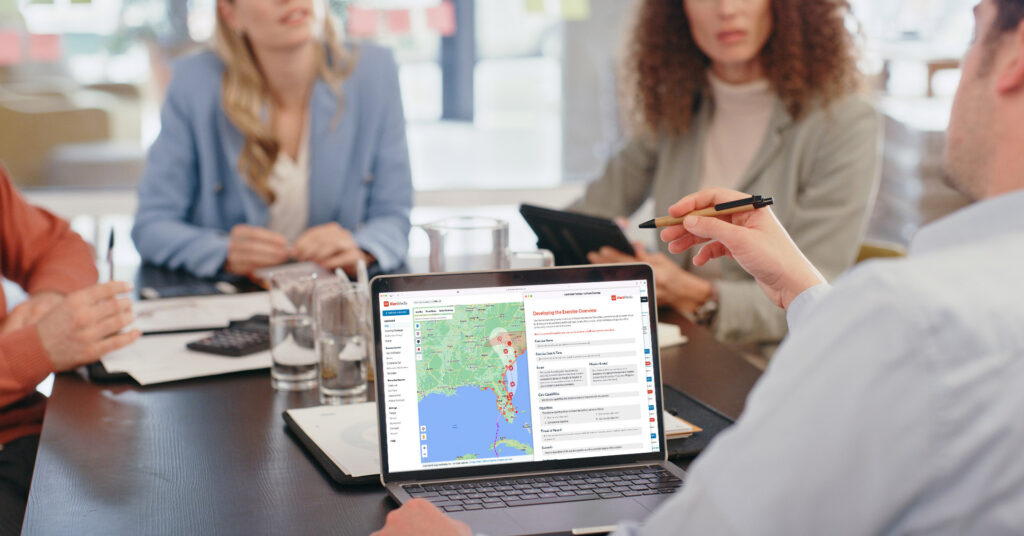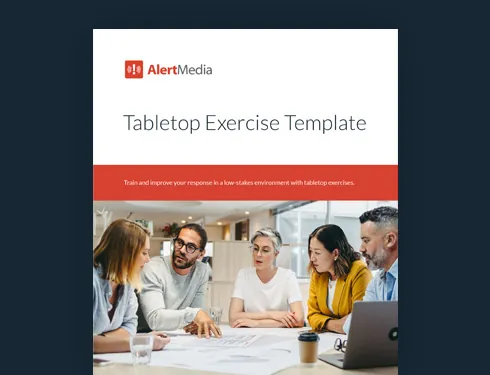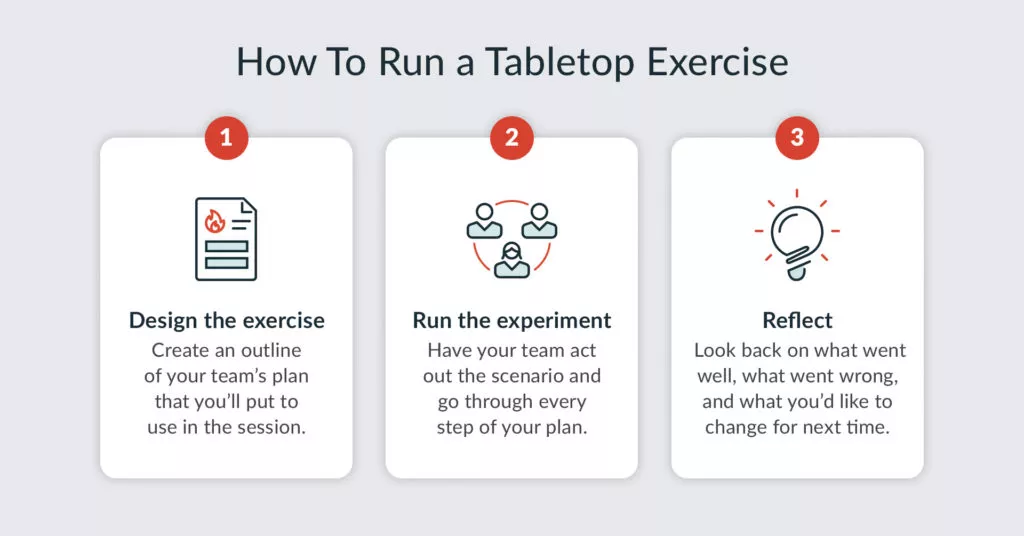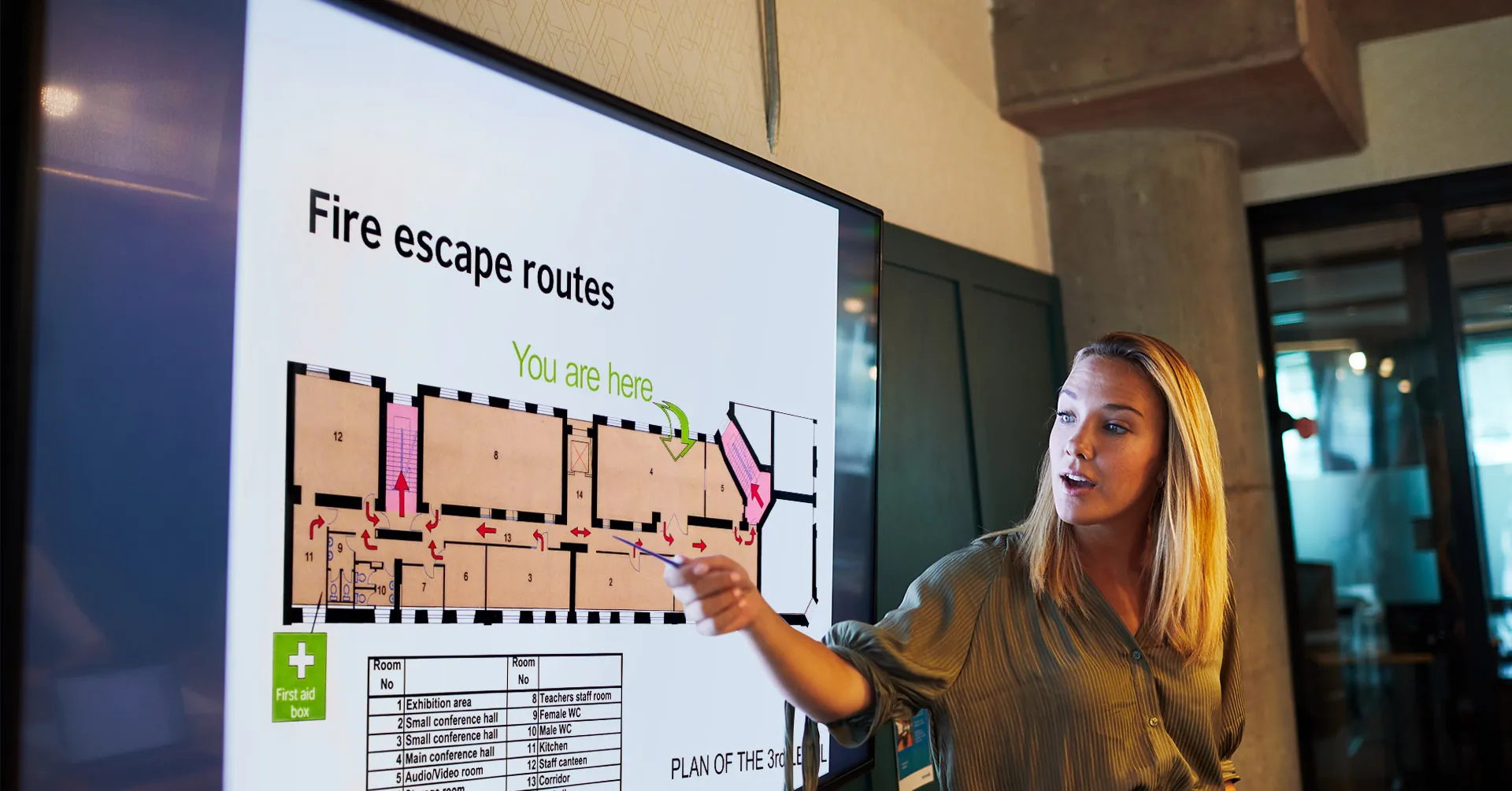To ensure your operations are resilient and your people stay safe, be ready to meet a hurricane head-on. Rehearse your response plan and identify gaps with hurricane drills and tabletop exercises.

Run a Hurricane Drill or Tabletop Exercise: Guide & Template

To keep your people safe and your operations resilient, your organization needs to be ready long before the first hurricane warning is issued. Every year, businesses in hurricane-prone areas test their emergency plans through a mix of drills and tabletop exercises—rehearsing communication, resource deployment, and decision-making under pressure.
Hurricanes are unpredictable and fast-moving, often changing in intensity with little notice. Your ability to protect employees, facilities, and assets depends on how well your teams can follow clear procedures and adapt when the unexpected happens. Running hurricane drills and hurricane tabletop exercises allows you to test these procedures safely, evaluate decision-making, identify gaps, and strengthen coordination—whether practicing a quick on-site drill or leading a cross-functional tabletop discussion.
As English writer Charles Caleb Colton once said, “It is better to meet danger than wait for it.” That philosophy still holds true today—especially during hurricane season. You can’t control the storm, but you can control how ready you are to meet it head-on. With well-planned drills and discussion-based tabletop exercises, you’ll transform your hurricane response plan from words on paper into real-world readiness.
What Are Hurricane Training Exercises?
Effective hurricane preparedness isn’t just about having a plan—it’s also about regularly testing that plan under realistic conditions. Hurricane exercises allow organizations to evaluate how well teams communicate, coordinate, and respond as a storm unfolds. Depending on your objectives, you can choose from several types of exercises, each building a different level of readiness.
Hurricane drills
Drills are short, focused rehearsals that test a single procedure or skill. For instance, you might practice sending alerts through your notification systems, checking weather radios, or deploying emergency supplies. These quick, hands-on activities help employees understand their roles and become comfortable performing safety actions like sheltering in place or securing equipment before the storm hits.
Hurricane functional exercises
Functional exercises simulate a live event in real time to test coordination and decision-making across departments. Teams may respond to updates from the National Weather Service (NWS) or NOAA, communicate via emergency apps, and troubleshoot disruptions in infrastructure or staffing. These simulations help leaders evaluate operational readiness without conducting a full field exercise.
Hurricane tabletop exercises
Tabletop exercises are discussion-based sessions that bring key decision-makers together to walk through a realistic hurricane scenario. Participants talk through steps they’d take during a hurricane warning, discuss challenges, and identify gaps in plans and communication.
Hurricane full-scale exercises
Full-scale exercises combine everything—people, procedures, and resources—into a complete simulation. These complex exercises often involve coordination with outside partners such as the Red Cross or Federal Emergency Management Agency (FEMA) and can include mock evacuations, facility shutdowns, or first responder engagement.
Together, these exercises create a layered approach to hurricane preparedness, ensuring your organization can respond quickly and effectively no matter how severe the storm.
From Drills to Tabletop Exercises: Building a Complete Hurricane Readiness Cycle
Hurricane drills and tabletop exercises each play a vital role in strengthening preparedness—but together, they create a continuous improvement cycle that keeps your organization ready for anything.
Drills test your ability to act. They give employees the chance to practice physical procedures like activating notification systems, securing equipment, or moving to safe areas before hurricane warnings are issued. These quick, hands-on rehearsals reveal gaps in execution—such as missing emergency supplies, unclear evacuation routes, or equipment that doesn’t perform as expected.
Tabletop exercises, by contrast, test your ability to think. They bring decision-makers together to discuss critical choices—when to close offices, how to maintain communication during a storm surge, and how to coordinate recovery efforts if power or transportation are disrupted. The discussion-based format allows leaders to explore the “why” behind each action and adjust strategy without the pressure of a live event.
When used together, emergency drills and tabletop exercises reinforce one another. Insights from tabletop discussions can inform the next drill’s objectives, while issues uncovered during drills can shape the scenarios you explore in tabletop sessions. By alternating between practice and reflection, your organization creates a living hurricane preparedness program—one that evolves as new risks emerge, technology changes, and your people gain confidence in their ability to protect one another when the next storm arrives.
How Do You Run Effective Hurricane Drills?
Tabletop exercises allow for discussion, but drills put your plans into action. These practical sessions simulate specific steps of your hurricane response—from alert activation to sheltering in place—so your teams can identify inefficiencies and safety issues in real time.
Before the drill
Set clear objectives for every drill. Define what success looks like—whether that’s reaching every employee within five minutes of a hurricane warning or ensuring first aid kits are deployed to the right areas. Assign a Safety Officer to oversee conditions, test alarms, and confirm accessibility for employees with disabilities.
Your planning team should also review site hazards. Inspect gutters and drainage systems, check floodwater pathways, and ensure your emergency supplies—including weather radios, flashlights, and smartphone chargers—are stocked and operational.
During the drill
Kick off the drill with a simulated notification system alert, such as an update from the National Weather Service or NOAA. Have participants perform their assigned actions: sending alerts, securing property, relocating critical assets, and confirming two-way communication. Drills should feel realistic but safe—an opportunity to practice without panic.
After the drill
Hold a brief review immediately after completion. Discuss what went smoothly and where confusion occurred. Did messages reach all employees? Were apps or radios reliable? Did the emergency kit contain everything needed? Treat every lesson as a process improvement, not a failure. Document findings, assign owners, and schedule follow-up drills to confirm progress.
By repeating these cycles regularly, your team will strengthen coordination and ensure every individual knows what to do before, during, and after a hurricane.
The Basics of a Hurricane Tabletop Exercise
A hurricane tabletop exercise, or TTX, is a way to assess your organization’s emergency response plan to these natural disasters. These exercises are more important now than ever, as hurricane season predictions show these storms are growing more destructive and less predictable.
During a recent episode of The Employee Safety Podcast, AlertMedia’s senior meteorologist, Jason Moreland, pointed out that our ability to predict the intensity of these storms hasn’t kept pace with the massive population growth in hurricane zone states like Florida, Texas, South Carolina, and Georgia. Meanwhile, employers have larger, more decentralized workforces that they must manage during one of these critical weather events. Finally, weather patterns show that we’re seeing more storms rapidly jump in intensity right before landfall, leaving many unprepared for the devastation they leave behind.
As Colton says, the only way to address the danger is to meet it head-on with an emergency preparedness plan. Your tabletop exercise is the opportunity to test that plan in a low-stakes environment so you can iron out any issues before the severe weather.
As the name implies, it’s an exercise held at a table that allows the participants to discuss various scenarios and walk through their responses. Very broadly, there are three stages to a TTX that your organization should follow.

Get the Tabletop Exercise Template
Designing Your Hurricane Preparedness Exercise
The design of a tabletop exercise scenario is made up of three elements: plans, people, and goals. Specifically, you’ll need to evaluate your current hurricane emergency plan, assign roles to your participants, and set some benchmarks to meet.
What are you testing?
A tabletop exercise doesn’t have to test the entire hurricane preparedness plan. Any emergency response plan is pretty extensive. It will cover everything from communication to evacuations, transportation, loss mitigation, and more. Testing all of these at once may not be feasible. A hurricane tabletop exercise is great for evaluating small portions of it.
Instead, you may break these tests down into smaller bite-sized components. That can help you focus and quickly identify areas of improvement. That was how Beth Harbold, Director of Quality Assurance and Emergency Management at Family First Homecare, handled it when updating her hurricane communications plan for the organization. Being responsible for 400 vulnerable patients across four states, Beth needed to be able to quickly communicate and document her outreach attempts to patients during hurricanes.
While testing her hurricane communications system alone, she realized that none of the messages were attached to a specific office, compromising timely and relevant messaging. This small, seemingly insignificant issue could have caused massive repercussions during a storm. Afterwards, when she put her broader communications plan to the test, Beth was able to understand and correct this problem of location-based alerts. That allowed her to ensure the most efficient message delivery during a hurricane event.
Depending on the size of your organization, it may make sense to do what Beth did. Break your response plan testing into a series of smaller hurricane tabletop exercises. Test out the individual components before bringing it together for a larger emergency drill. That way, you can address issues you may have overlooked and control the number of participants.
Who is participating?
A hurricane tabletop exercise isn’t a full-scale disaster drill, so including every stakeholder may not be necessary. Mainly, you will need enough involved participants to fill four critical roles in the TTX.
Facilitator | Evaluator
The evaluators will document results, as well as both positive and negative impressions. They will also lead the after-action review.
| Observer | Participants
Your participants are the parties who are going to be responding to the hypothetical scenario that the facilitator lays out.
|
What are your goals?
By defining specific goals for your tabletop exercise, you gain valuable insights into your preparedness and areas that require improvement. These goals indicate your readiness, guiding you toward enhancing your emergency response capabilities. Without these benchmarks, gauging your tabletop exercise’s success and identifying growth opportunities would be challenging.
When possible, quantify those exercise objectives. For example, a hospital might set a goal to “Demonstrate efficient communication and information sharing between all hospital departments and key personnel during the exercise.” While that’s a great goal, it cannot be quantified. A more specific goal, like “Achieve 90% success rate in efficient communication and information sharing between all hospital departments and key personnel during the tabletop exercise,” is better because it gives a clear, numerical result.
Running Your Tabletop Exercise
With the design complete, you’re ready to run your tabletop exercise. Choose a private, distraction-free location that allows for collaboration. The facilitator should start the activity by introducing key roles, reminding the participants of goals and objectives, and reading the brief.
The brief is a summary of the hurricane scenario, given with as much detail as would be reasonable in a real event. For example, a hospital might lay out the following situation to start their hurricane tabletop exercise.
Hurricane Abner, a powerful Category 4 storm with sustained winds of 130–156 mph, is approaching the region and is expected to make landfall within 72 hours. Evacuation orders have been issued for individuals in coastal or structurally vulnerable areas. The hospital, located on a main road and currently housing 400 patients, is taking immediate action to prepare for the storm’s impact.
The facilitator then goes over some prompts covering what actions to take based on the disaster plan. They may ask participants to walk them through patient evacuations, structural assessments, or communications to get the conversation flowing.
Participants would then respond to those prompts, again based on the details laid out in the disaster plan. When responding to participants’ answers, the facilitator should attempt to draw out details. For example, if one of the participants answered that they would activate the emergency communications system in response to the above scenario, the facilitator would ask several follow-ups to define that step, such as:
- Who has the authority to activate the system?
- Who physically activates the system?
- How will you confirm this is done?
- Who is on standby if someone can’t perform their task?
- What additional challenges might they face?
These questions drive the scenario forward and allow the participants to identify gaps in their plan. Once the flow of the hurricane tabletop exercise is established, it’s time for the facilitator to add some injects, updates to the situation.

Building Your Tabletop Scenario: Timeline and Injects
A hurricane rarely unfolds in a straight line—and neither should your tabletop exercise. By structuring your scenario around a realistic timeline and layering in “injects” that reflect how storms evolve, you can make your exercise far more engaging and effective.
Create a realistic timeline
Your scenario should progress just like an actual hurricane does, from early warnings to landfall and recovery. Begin with a tropical storm forming offshore and track its development through the National Weather Service (NWS) and National Hurricane Center (NHC). Over several simulated “days,” escalate the situation as watches become hurricane warnings, strong winds intensify, and heavy rains begin to cause localized flooding.
At each stage, participants decide when to activate notification systems, deploy emergency supplies, or issue internal updates to employees and partners. As conditions worsen, prompt your teams to assess facility safety, monitor storm surge threats, and coordinate with local authorities and FEMA for potential evacuation guidance.
A typical timeline might look like this:
- Day 5: The National Hurricane Center issues its first advisory. Teams begin reviewing communication plans and ensuring weather radios and apps are functional.
- Day 3: Forecast models predict rapid intensification. Operations teams inspect gutters, secure loose items, and verify that generators and first aid supplies are ready.
- Day 1: A major hurricane warning is issued. Staff shortages occur as some employees evacuate. Communication leads confirm mass alert readiness.
- Landfall: Storm surge and floodwater impact low-lying areas. Power outages disrupt parts of the facility. Teams implement shelter and safety procedures.
- Post-landfall: Recovery begins—evaluate structural damage, update leadership, and prepare claims for insurance policies.
Add injects to increase realism
Injects are mini-scenario twists that challenge your team to respond dynamically as the situation changes. They test flexibility, coordination, and communication under stress. Consider the following examples:
- Power outage: The hurricane’s strong winds and heavy rains knock out power. How will teams maintain communication when backup systems fail?
- Floodwater hazard: A storm surge floods the facility’s lower level. Who handles safety measures, and how do you verify emergency supplies remain secure?
- Evacuation order: Local authorities or FEMA issue an evacuation order due to severe weather conditions. Who decides when to relocate staff?
- Staff shortage: Transportation routes are blocked, and several employees can’t report for duty. What’s your backup plan?
- Structural damage: High winds cause roof and window failures, and the building sustains water damage. How will your continuity and safety teams respond?
- Secondary hazards: The storm triggers gas leaks and hazardous material spills nearby. How do you protect on-site employees while maintaining communication?
Each inject should relate back to your exercise objectives—whether evaluating the speed of decision-making, the clarity of communication, or how well teams coordinate across departments.
By combining a structured timeline with realistic injects, your tabletop exercise will more accurately mirror the chaos of a real hurricane. This approach transforms a static discussion into an immersive simulation—helping your organization uncover blind spots and strengthen its ability to weather any storm.
Reviewing and Documenting Your TTX Results
After testing hurricane scenarios, you must evaluate your results. The evaluator takes center stage here, reviewing the positive and negative aspects. This after-action review (AAR) should be held as soon as possible after the exercise. Sometimes called a hot wash, this session will help you answer four questions:
- What was the plan?
- What was the outcome?
- Why was that the outcome?
- How can you improve?
Avoid assigning blame during your hot wash. Instead, look at where resources and communication failed as issues of process, not people. This approach encourages a more free-flowing conversation where everyone feels safe to share their insights. The leader of the AAR should encourage a problem/solution format, where individuals who bring up issues also come up with an improvement plan. That keeps the conversation productive.
Recognizing and celebrating the successes of your TTX is equally vital during the AAR. Take the time to acknowledge your team’s strengths and consider how to leverage them more effectively in the future. An AAR often reveals untapped resources and previously unknown skills, unlocking new potential for growth and improvement. Embracing these positive aspects can lead to valuable discoveries and enhance your team’s overall capabilities.
The AAR should allow you to develop an after-action report that you will use to summarize your findings and share them with your team. That after-action report should cover the answers to the above four questions and any action items you’ll take to improve. You can develop your own format or use an after-action report template to map out your ideas. You can download our after-action report template here.
Resource Management for Hurricane Preparedness
Successful hurricane response depends on more than procedures—it relies on well-managed resources, trained people, and solid partnerships. When a storm is approaching, those preparations become your organization’s lifeline.
People and staffing
List out all critical roles—Incident Commander, Communications Lead, Facilities Manager, and Safety Officer—and ensure at least one trained backup for each. Cross-train teams wherever possible. For employees with disabilities, maintain individualized evacuation and sheltering plans and ensure they’re practiced during drills and tabletop exercises.
Supplies and equipment
Keep your emergency kits fully stocked with essentials like first aid materials, food, water, and spare weather radios. Facilities staff should inspect gutters and storm drains before hurricane season, test generators, and confirm emergency lighting. During drills, verify that smartphones, apps, and communication systems remain reliable if power or internet connections fail.
Information and partnerships
Maintain real-time awareness through official updates from the National Hurricane Center, National Weather Service, and NOAA. Establish coordination with local agencies, FEMA, and the Red Cross for recovery assistance and resource support. Review your insurance policies annually to ensure coverage aligns with current facility risks and equipment values.
Continuous improvement
After every hurricane season or major exercise, evaluate your resource inventory. Replace expired materials, note gaps revealed in your after-action reviews, and document all restock and maintenance tasks. Consistent resource management ensures your organization never has to scramble for supplies or support when a real storm hits.
Meet the Storm With Proactive Planning
The unpredictability of hurricanes makes testing your preparedness plan essential. Rather than waiting for the storm to strike, meet it head-on by practicing your response—whether through a quick hurricane drill or a detailed tabletop exercise. Each helps your teams identify weaknesses, strengthen coordination, and build resilience needed to protect your people and operations when the next storm arrives. Leaders who meet the danger are best prepared to weather it with strength, resilience, and a well-rehearsed plan of action.
Are you ready to test your response with a hurricane emergency exercise? Use our Tabletop Exercise Template as a starting point—it can easily be adapted for drills, functional exercises, or broader emergency preparedness training.






